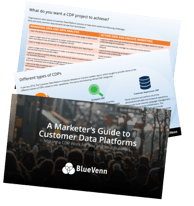 It can be a relentless challenge trying to keep up with new technologies, not to mention all the acronyms and buzzwords that come along with them.
It can be a relentless challenge trying to keep up with new technologies, not to mention all the acronyms and buzzwords that come along with them.
Our new eBook, A Marketer’s Guide to Customer Data Platforms, is here to clear up some of this confusion by delving into precisely what a Customer Data Platform (CDP) is and why it’s vital for marketers to recognize the differences between them and other forms of data solutions.
If you get any of the following confused with a CDP, you wouldn’t be the only one. So, we’ve highlighted some of the most common technologies that crop up in our conversations with companies looking to take more control over their customer data.
Data Warehouse
A Data Warehouse, also known as an Enterprise Data Warehouse (EDW), is a repository for large amounts of business information. The EDW structures this data for use in analysis and business intelligence.
Why is a Data Warehouse different to a CDP? EDWs contain data from sales, marketing, purchasing, finance and other areas of the business, storing all corporate data. A CDP, on the other hand, only gathers customer data and is specifically designed to be used and operated by marketers. And whilst a CDP is continually refreshed, EDWs are not updated nearly as frequently, often resulting in invalid or poor quality data.
Data Management Platform
A Data Management Platform (DMP) collects and stores data from a range of sources and makes segmented demographics accessible to other platforms.
Why is a Data Management Platform different to a CDP? DMPs mostly use third-party data to target anonymous cookies for advertising, whereas a CDP uses first-party data to deliver a personalized experience for each customer across multiple channels. Therefore a DMP is primarily designed to target unspecified customers rather than providing a tailored customer journey.
A Marketer’s Guide to Customer Data Platforms eBook

Customer Relationship Management
Customer Relationship Management (CRM) collects and merges customer data from multiple touchpoints (such as your website, telephone, email, live, and social media) to help businesses manage their customers.
Why is Customer Relationship Management different to a CDP? Whilst CRM helps optimize a company’s interactions with existing customers, it is unable to identify or engage with customers that it is not familiar with. A CDP however can identify new customers using data from various sources to create a Single Customer View. In turn this enables marketers to personalize the customer experience, whereas CRMs are better suited to help salespersons manage their customer accounts.
Master Data Management
Master Data Management (MDM) is a set of processes that a business undertakes to ensure that their data is shared effectively throughout the organization. By providing a single point of reference, it allows IT and the rest of the organization to work together to ensure that data is shared efficiently.
Why is Master Data Management different to a CDP? While MDM can unify data to create a ‘single source of truth’, it is not specifically designed for the needs of marketers. Therefore, MDM is not traditionally a marketing-led (or marketing-operated) initiative. An MDM does not enable a Single Customer View, and unlike a CDP, MDM does not easily connect to your marketing delivery systems.
Tag Management System
Businesses use a Tag Management System (TMS) in order to assist with the implementation and management of tags on their digital properties, such as their website. A tag is piece of code that is embedded into a website in order to record customer information and how they interact with the company.
Why is a Tag Management System different to a CDP? Unlike a CDP, a TMS does not prioritize the collection of clean customer data to provide an insightful analysis of a company’s audience. A TMS can be fed into a CDP to provide a more enhanced view of the customer but it does not automatically facilitate this by itself.
Want to know more? Download the ‘Marketer’s Guide to Customer Data Platforms’ eBook

This blog article is an extract from BlueVenn’s ‘A Marketer’s Guide to Customer Data Platforms’ eBook.
Download a copy of the full eBook for more CDP advice, how a CDP differs from other data management technologies, or the different types of CDPs and what to look out for when researching technology vendors.









